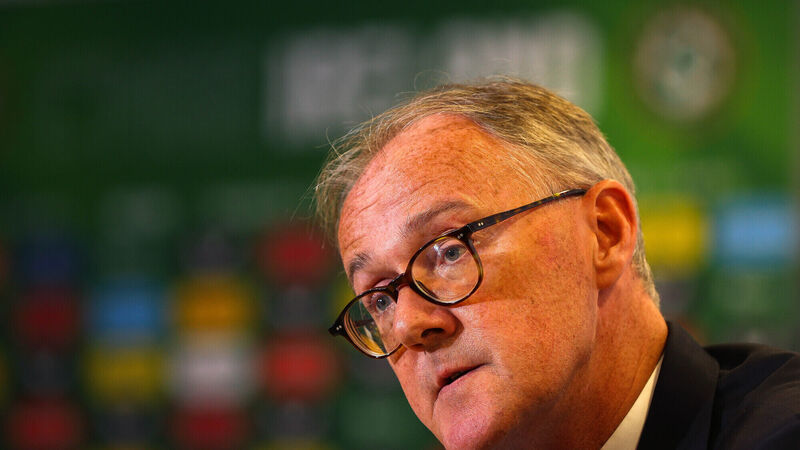Home truths flow from FAI HQ

15 YEAR BLUEPRINT: Roy Barrett and Jonathan Hill spoke on their 82 page document submitted to Department of Sport and Government. Pic: ©INPHO/Ryan Byrne
It was heartening to hear the FAI use their own backyard to deliver a dollop of home truths yesterday.
From the same chairs at Abbotstown we’ve gotten used to being fed fanciful soundbites, usually from the senior men’s team manager. Roy Barrett and Jonathan Hill did a great job in talking their game down.
Irish football, as outlined with empirical evidence is the poor relation compared to the golden child of GAA when it comes to State aid. Though football is the largest participative code in the country, the FAI lag by multiples the annual turnover generated by their rugby and GAA federation counterparts.
Just three football stadia reside in the top 40 nationwide for capacity, two of which — Tallaght and Turner’s Cross — are among the bottom three. A gallery of pictures in the glossy brochure featured the decaying stands and pitches at various LOI venues.
Finally, confessions on FAI headquarters. Bad enough is the dour, grey exterior to their office resembling an Eastern Europe bunker during the communist era but the playing facilities outside are also bog-standard.
Broadening to international comparisons cements the sobering reality, Ireland has the second lowest record, 0.4%, of GDP spent on sport, across the European Union. Ireland is one of just 12 countries across Uefa’s 55 members not to complete a full stadium project between 2009 and 2018.
If the FAI lurched on financial bankruptcy in 2019, the €863m, 15-year blueprint unfurled yesterday, first flagged by the on Tuesday, confirms they are infrastructurally destitute.
Only the public purse, bulging with enhanced corporation taxes, can provide the sustenance to ensure the 82-page manuscript isn’t lamented in time as the latest example of words without action.
The association, while eventually shaving their debts down from €63m to €44m over the past months, will be padlocked by repayment deals for the foreseeable future and so can only commit to stumping up 20% of the overall pot.
That vow in itself, translated into €60m of outflows up to 2030, warrants scrutiny given the assumptions around revenue streams, including a dependency on League of Ireland clubs chipping in directly.
What will ultimately frame the viability of this wish-list are the appetites of the rich and powerful.
That’s politicians who aren’t browsing beyond the next election and billionaires whose previous record on financial support for Irish football was restricted to subsidising salaries of the men’s team managers.
“We felt it was important to get this strategy circulated before the recess,” chief executive Jonathan Hill admitted about Leinster House halting for holidays next month.
“We’ve have talked to the Department of Sport and government accordingly. In an ideal world, I’d see this starting in 2024. This is the start of the debate.”
And that debate will rumble on. Political reaction has been underwhelming to say the least, the likes of Paschal Donohoe and Thomas Byrne preferring to concentrate on the existing schemes, such as the Sports Capital Programme opening this week, as a means of clubs at all grades accessing state grants.
A parting line to Claire Byrne on radio by Donohoe, bean-counter extraordinaire as head of public expenditure, imploring the FAI not to rely on the taxpayer for everything, has been construed as injecting an early dose of realism into what’s an aspirational charter.
Only Sinn Féin spokesperson on Sport, Chris Andrews TD, offered his tuppence and that was merely urging the incumbent parties to engage with the FAI.
What we can expect from the body politic next year from a football perspective are a slew of representatives trumpeting grants secured for their local clubs through the established mechanisms.
Worthy causes for money generated through the other avenues listed by the FAI, such as their new foundation and an increase in the betting tax, will be chosen internally. Or that’s what it seemed until Hill’s answer meandered.
“The fund will decide that,” he said. “That will have an independent board but we, the FAI, will be part of that board and so will other stakeholders, such as Sport Ireland.
“Money will flow in and money will flow out on the back of it. The whole of that process is for debate with our stakeholders, including the Government, as to how that might work. We would have to work in tandem with the State’s existing two programmes.”
Barrett, chairman since January 2020, has been linked with moving across to that new arm to utilise his contact list to bolster philanthropy from wealthy individuals towards investment.
“No,” he affirmed about moving sideways. “I will be here (as chairman) until no later than the end of the year and as such time until a replacement is found — a process that’s ongoing currently.
“I think new people with new ideas, different thoughts and voices are the right thing for any organisation. But what I will do, and I have done this voluntarily as I have a passion and interest for it, is I'll help the organisation in any way that it wants me to help them in the future.”
:
: Irish football’s Social Return on Investment according to a UEFA report, two thirds of which is on healthcare savings.
: Players and volunteers involved in football, broken into 220,00 and 45,000 respectively.
: Number of registered females anticipated to be playing football in Ireland by 2026. “There’s 34,000 now and numbers are growing like the clappers,” said Roy Barrett, citing the upsurge of interest from World Cup qualification.
: Total amount the FAI are seeking for their plan outside of football means, central government funding coupled with local councils/health boards and educational institutions.
: Cost of modernising League of Ireland stadia with capacities, in some cases, up to 20,000. “We want two stands looking at each other,” said Jonathan Hill. “One to have modern broadcast and media facilities to look across at hopefully a full stand at the other side of the pitch.” UCD and St Patrick’s Athletic are the two Premier Division clubs with only one stand. In the First Division, it’s Cobh Ramblers, Wexford, Treaty, Finn Harps and Kerry.
: Average amount allocated to each of the 20 LOI clubs to develop a training pitch and academies. Some will get more than others, depending on four categorisations decided by the FAI.
: Number of Irish clubs currently awaiting decisions on applications to the Immigrant Investor Programme. A hefty chunk are LOI, among them Shamrock Rovers and Shelbourne, with the total sought amounting to €96m. “It would be a significant impetus to this overall plan if those mainly LOI-club related applications were successful,” said Hill.











